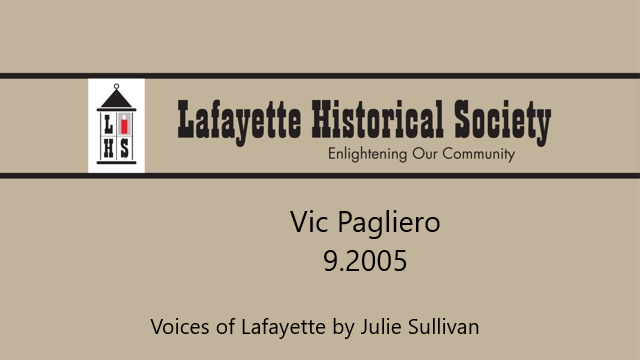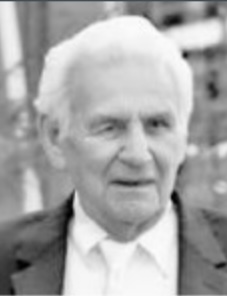Summary:
Vic Pagaierò was interviewed by Julie Sullivan in September 2005. He was born in Oakland in 1923. At age 13 he moved to Moraga and began a long career as a ranch hand and farmer. He married Ruby in 1949, and that year he also went to work operating a rototiller for landowners in the Glenside and Happy Valley areas of Lafayette. This was seasonal work, and when Vic needed an alternative job he found it at the walnut processing plant in Walnut Creek. In this interview he describes what it was like to live in Lafayette at the time when it was just beginning to see rapid development as a commercial center and when its flat areas were about to be developed into residential communities.
Oral History:
Cattle drives evoke a vision of wide open spaces and the Old West – but the cattle drive Vic Pagliero took part in occurred in the mid-twentieth century, and even more surprisingly, in Moraga and Orinda.
“It was around 1944, because I was home on furlough,” Vic remembers. “There must have been about a hundred head of cattle and twenty head of horses. John Avila had rented land from the Moraga Land Company for his dairy. When Don Rheem bought the land, John had to move his dairy herd off the property. Eight or ten of us drove the cattle right through Moraga and Orinda, then down the Dam Road to El Sobrante. We had dogs, they call them Australian Shepherds, to keep the cattle in line.”
It took two days to drive the herd to El Sobrante. “The first night we spent near the Claremont Hotel,” he remembers. “People then didn’t think anything if traffic was stopped for a little while. In fact they enjoyed it. They used to stop and watch.”
Vic was born in Oakland in 1923, where his father opened a cigar store across from the Paramount Theater. “I went to grammar school in Oakland until seventh grade, when I moved to Moraga and stayed on a ranch owned by Jack Souza. I had spent weekends there, and I never liked the city, so when the Souzas asked if I wanted to stay permanently, I did,” Vic explains. “I played cowboy, rode horses and roped cattle. I was thirteen years old and, I could drive a truck.
“Jack rented 600 acres from the Moraga Land Company, which was owned by (James) Irvine. I believe they had around 13,000 acres that they leased to ranchers. (The original land grant called Rancho Laguna De Los Palos Colorados – Ranch of the Lake of the Redwoods – which Juan Bernal received from the Mexican government in 1835 contained 13,316 acres. It included Canyon, Redwood, Rheem and Moraga and parts of Orinda and Lafayette.). I read where they had 600 acres in pear orchards in 1912.”
Vic attended grammar school at the Moraga School. “We used to ride our horses to school and put them in the barn there. I took the train to Mt. Diablo High School in Concord my first year, then I attended Acalanes High School my second year.” Vic left school in 1942 to join the Marines. During World War II he was stationed in Alaska and Washington state and was discharged in 1946.
“They used to farm where Campolindo High School is today,” he remembers. “They raised oats to make hay for the horses.” One of Vic’s early jobs was baling hay. “It took six or seven men to run the baler. We would go to the various ranches and do threshing. I used to put in a ten- hour day. When we were trying to get a crop in, I’d work a week or two straight.” Vic also drove a tractor for Louis Olivera. “His dad, Joe, owned forty acres on Los Palos Drive and Glenside Drive. It was planted in walnuts, pears and peaches. They used to call him ‘Peach’ Olivera.”
Vic and his wife, Ruby, were married in 1949, and he began to work cultivating and discing ground. “I worked mainly in Glenside and Happy Valley,” he says. “In those days I used to work ten hour days, sometimes six or seven days a week. In the fall when things were slack, I worked in the walnut plant in Walnut Creek. We used to run 7,000 tons of walnuts through there. Today, I bet you couldn’t get seven tons. All the way from Walnut Creek through San Ramon was all walnuts. Then the subdivisions grabbed all the flat ground and the walnuts disappeared.
“The railroad went to the walnut house on California Street. At first when the walnuts were processed, we put them in gunny sacks and sewed them up by hand. Later, they put in a chute that dumped them right into the train cars. That cut out a lot of labor cost. I guess they couldn’t afford the dollar fifty an hour they paid us.
“The El Rey in Walnut Creek was the only movie theater around then. I could drive in Moraga but not in Walnut Creek, so Sam Carr, who was older, used to drive us to the movies,” Vic says. “They used to have dances about once a month in the old Moraga School, like every community did in those days. They’d have a three-piece band, and the dances were always packed.
“The old veterans hall was built for $6,000. There was a big hill next to the hall. They hauled the dirt away, and now it’s a hardware store.
“After the war they built two nice homes on Moraga Road where Glorietta comes in,” Vic recalls. “They completely furnished them inside and put them up for sale for $12,500 each. People couldn’t believe anyone would pay that much for one house. Another time a contractor built a house in Upper Happy Valley. He was asking $18,000, and the ground was all full of weeds. He wanted to sell it fast, so he asked me to give him a deluxe job. Everything back then that was a little better, including cars, was called deluxe.
“We used to hunt all the time,” Vic adds. “We used to shoot deer when it was the season. We always got a couple. We’d dress them out and take them to Williamson in Walnut Creek, who’d butcher them and freeze the meat. You had to rent a locker. Nobody had freezers in those days.
“We didn’t have tree squirrels here then. There were ground squirrels, and the county was killing them because they thought they carried disease.
“Where Safeway is was overgrown with blackberries. There was a hill thirty feet high from McCaulou’s to First Street. I used to disc the top of that hill. Russ Bruzzone tore it down and hauled the dirt to Concord Four Corners, where Orchard Supply is now. There were so many trucks of dirt going back and forth to Concord, they said it looked like the Southern Pacific Railroad.
“From the shopping center in Moraga there is a Y in the road; one way led to St. Mary’s College. The other way was the Lucas property. Rheem Boulevard was a dirt road that ran over the hill. Electricity hadn’t been run all the way out there. In Moraga there were corrals next to the train depot to keep the cattle shipped here until their owners could pick them up.
“The Malley family lived in Happy Valley. The grandfather started building houses, and the grandsons, Chuck and Jack, built houses behind the old Cape Cod restaurant (Celia’s).”
Vic built a house in Moraga fifty years ago where he still lives. His wife passed away in 1976. He has four children and eight grandchildren. “I still cultivate ground,” he says. “I work for Ollie Hamlin, turning the grass down on his property to protect against fires. I have a fifty-inch rototiller and a Ferguson tractor. I work about three months, from about March to July, depending on when the rain stops.”
Excerpted from “Voices of Lafayette” by Julie Sullivan. This book is available for purchase in the History Room.



Leave a Reply